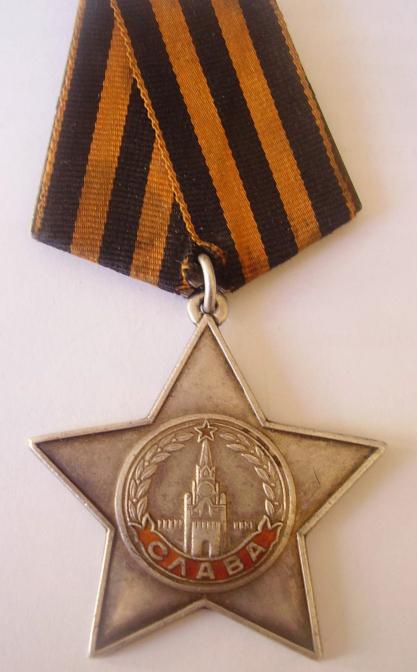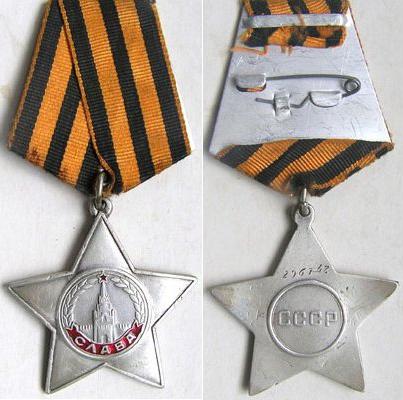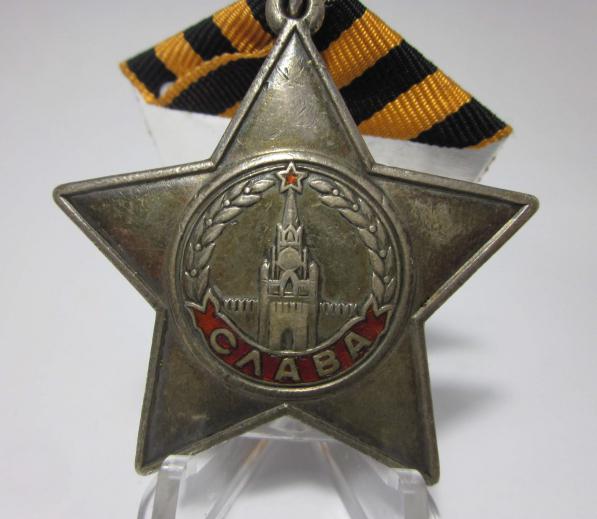Not everyone knows that on June 20, 1943, at a meeting of the People's Commissar of Defense of the Soviet Union, the question of creating a draft Order of Victory was discussed . By that time, the top leadership of the Soviet country no longer doubted the victory of our troops over Nazi Germany. In this connection, right at the meeting, the Supreme Commander-in-Chief proposed the establishment of a military award, arguing that there would be no victory over fascism without military glory.
How the Order of Soldier Glory was born
Already in early August 1943 Aginsky S.V., who headed the technical committee of the Main Red Army Directorate, received a responsible task, which consisted in the development of a draft of a new military order. Immediately 9 artists began to work, who created about 30 sketches, 4 of which were submitted to Stalin personally for approval. Joseph Vissarionovich chose one of them. It was the work of the artist Nikolai Moskalev. He was the author of all the orders that were awarded to soldiers for the defense of Soviet cities, as well as the Order of Kutuzov.
The author of the project proposed the establishment of an award with four degrees of distinction, similar to the St. George Cross. According to the idea of Moskalev, a military award could be called the Order of Bagration. It was no accident that the artist took the St. George Order as the basis, since he was the most revered among the soldiers of that time.
The sketch of the award and the idea of the author were approved by Stalin, however, he insisted that the award should be called the Order of Glory. In addition, he ordered to reduce the number of degrees of distinction to 3 in order to equate the order with the awards of commanders. The Order of Glory was finally approved on October 23, 1943, and soon the minting of the first samples of the award began.
A bit about military regalia
The promotion of military personnel began with the award of the lowest degree of distinction. Then followed the awards in increasing ─ II degree of distinction and I. The award of the highest degree of distinction was made of gold, silver was used to mint the award of the II degree. The central image on the medallion itself is a gilded Frolovskaya (Spasskaya) tower.
At various times in the existence of a soldier’s award, its appearance changed several times. At the same time, not everyone knows that the arrows on the tower chimes also showed different times each time. The Order of Glory of the III degree had the same composition, only the image of the medallion was not covered with gilding. The cavaliers of this order could be assigned the next military rank out of turn at the request of the command of the unit. For example, the foreman could immediately become ml. lieutenant, and he, in turn, receive lieutenant epaulettes.

The Order of Glory of the 3rd degree of the Second World War could be presented to a distinguished warrior by a brigade commander or an officer who held a higher position. Army or flotilla commanders made a decision and signed a decree on assignment to the awarding of military personnel with the Order of the II degree. The Supreme Soviet of the USSR adopted a resolution on awarding soldiers with the Order of I degree of distinction. Since the end of February 1947, only the Presidium made the decision to reward military personnel.
Among the combined arms awards that were created during the years of opposition to the fascist occupation, the Order of Glory of the USSR was the last. True, the Order of Ushakov and the Order of Admiral Nakhimov were still issued after him, but they were used to award only Soviet sailors.
About the features of the soldier's award
The Order of Glory of the Second World War was special and differed from other awards. First of all, he was originally conceived as a soldier's reward. For the courage shown in battles, sailors and Red Army soldiers, as well as junior lieutenants of aviation, could receive it. Soviet officers could not receive this award.
A characteristic feature of the Order of Glory was the following: the award was given only to people for their military exploits. Military units could not apply for it, as well as various organizations. In addition, all three Orders of Glory had the same color coloring of the ribbon, which was a distinctive feature of the pre-revolutionary military regalia.
Detailed insignia
The order is made in the shape of a five-rayed star, and the distance between the vertices of the star itself is 46 mm, each of which has a convex surface framed by sides. In the center of the order is the circumference of the medallion with a bas-relief of the Kremlin tower, on which a ruby star is mounted. The lower part of the medallion has a ruby ribbon with the word “GLORY”, which is made with capital letters. On both sides of this ribbon, on the inside of the medallion there are laurel branches symbolizing victory.

On the central beam there is an eyelet through which a ring is threaded, due to which the award is fastened to the order block. The order block has a pentagonal shape, and its decoration is made with a moire ribbon, which is 24 mm wide. On the tape there are three longitudinal stripes of black color, as well as two orange ones, which alternate with each other and symbolize the flame of fire and smoke (St. George ribbon). An orange millimeter line runs along both edges of the tape. Thanks to the pin located on the back of the order pad, the award is attached to the clothes.
The Order of Glory was issued by the number, which was located on the back of the medallion. It must completely match the entry in the order book. Note that the Order of Glory of the III degree was made of silver, the weight of which in the product is about 20.6 g, with a total mass of 23 g.
The central circle of the medallion of the Order of the II degree has a gold-plated coating, and the weight of the award and the silver content coincides with the award of the III degree of distinction. The Order of the 1st degree was made of gold of the highest standard, which is contained in the award of 29 g, with a total weight of 31 g.
First awarded the Order of Smoke and Fire
Soon after the approval of the new order - 11/13/1943 - a historical event occurred. The first award, which was awarded to Senior Sergeant V. S. Malyshev. At that time he served as a sapper. He managed to destroy the machine-gun crew of the enemy, which did not allow Soviet soldiers to break through the enemy defenses. Later, Malyshev earned the same award of the II degree. Almost simultaneously with it, the Order of Glory of the III degree was awarded to sapper Sergeant G. A. Israelyan, who served in the 140th rifle regiment. The Krasnaya Zvezda newspaper wrote about this award, the next issue of which was released on December 20, 1943.
Awarding of Sergeant Israelyan took place on the orders of the rifle division command of 11/17/1943. This happened almost immediately, as soon as the award was established by order of the Presidium of the Supreme Council. Israelyan G.A. ended the war in the status of full knight of this order. Equally interesting is the rewarding of the lock servo-platoon of a battery of anti-tank guns by Sergeant I. Harin, who fought in one of the military units on the II Ukrainian Front. Ivan Kharin was awarded the Order of Glory of the III degree by order No. 1. He was awarded this award for the destruction of two self-propelled guns "Elephant" and three enemy tanks during one battle.

Sappers Andrei Vlasov and Sergey Baranov, who were awarded the Order of Glory, were the first to receive the Order of the II degree of distinction. At that time, they fought in the reconnaissance 665 battalion of sappers. At the end of November 1943, the reconnaissance company made a sortie into the enemy rear, while destroying wire fences, thanks to which the soldiers of the 385th Krichev Division managed to defeat the Nazi defense with virtually no loss.
About gentlemen and heroes who deserve a soldier’s order
It is believed that in the period 1941-1945 about 998 thousand Soviet soldiers received the Order of Glory 3 degrees. The list of awards continues to fighters in the amount of 46.5 thousand people who were awarded the Order of II degree of distinction. Much less than those who received the highest award. Awarded with the Order of Glory of the 1st degree, fighters had to perform a truly outstanding feat. There were 2620 such people.
Answering the question, how many cavaliers of the Order of Glory exist, it should be noted that there are a little more than 2.5 thousand full cavaliers. Of these, only four were awarded the star of the Hero of the USSR. These are senior artillery sergeants A.V. Aleshin and N.I. Kuznetsov, an assault aviation pilot, Jr. Lieutenant I. G. Drachenko and foreman of the guard Dubinda P. Kh. Note that 647 people - knights of the Order of the III degree and 80 - II degree were Heroes of the Soviet Union.
Interesting reward winners
On January 15, 1945, the 215th Infantry Regiment was located on Polish territory. At that moment, he was part of the 77th division, defending the Pulawski bridgehead, which was located in the area of the Vistula River. On this day, the 1st battalion of the regiment made a quick breakthrough and tore the solid defense of the Nazis. The soldiers continued to hold their positions until the main forces of the Soviet troops arrived. During the capture of Hitler's defense, Guardsman Petrov closed the machine gun of the German invaders with his own body, thanks to which the soldiers of the battalion quickly captured German positions. For this operation, each battalion fighter received the Order of Glory 3 degrees. The award list included the entire personnel of the battalion. Combat Major Emelyanov was posthumously assigned the Hero Star. The commanders of the companies of this battalion received the Order of the Red Banner as an award. The Order of A. Nevsky was awarded to the division platoon commanders.
On the courage of Soviet women
It is known that Soviet women also fought courageously during the war. Some were able to become full holders of the Order of Glory. Stanilien D. Yu. Became the first gentleman among women. During the war she served in the infantry division of Lithuania with the rank of sergeant and was calculated as a machine gunner. In one of the battles with German troops, her commander was seriously wounded. It was replaced by Danute and alone restrained the advance of the German infantry. For this, she received the Order of Glory III degree. By the end of the summer of 1944, nearby Polotsk, in the village of Lyutovka Danuta, the Nazi attacks were repelled, as a result of which more than 40 enemy infantry were destroyed. The Presidium of the Supreme Council of the Soviet Union on March 26, the victorious 1945, signed an order to award Stnilien D. Yu. The Order of Glory of the 1st degree.
A twenty-year-old girl came to the front of Rosa Shanina. She began the service in April 1944. She was a sniper, and on her account there were a lot of fought opponents. Only according to confirmed data, Rosa was able to destroy more than 50 Nazis. She managed to become a holder of the Order of Glory II and III degree. On January 28, 1945, near Ilmsdorf, Senior Sergeant Shanina heroically died at the age of 21.
The Soviet pilot, Nadezhda Aleksandrovna Zhurkina, in the middle of spring 1944, as part of the combat crew, flew over settlements in the Pskov region. During the completed 23 sorties, she managed to photograph the location of enemy units and military equipment, as well as repel a dozen attacks while in the air. Zhurkina received the Order of the III degree for courage shown in battles. Already in the autumn of the 44th, Zhurkina received an award of the II degree - for bombing the enemy on Latvian territory. Before the war ended, she received the Order of the highest degree of distinction for other accomplished feats.
Nina Pavlovna Petrova started the war at the age of 48 and joined the ranks of the division of the Leningrad people's militia. A little later she moved to the medical unit of the division. In the period from January 16 to March 2, 1944, in the battles with the Nazis, she destroyed 23 Nazis, for which she received the III degree award at the end of spring of the same year. Towards the end of the war, for personal exploits she received the Order of Glory of the highest degree of distinction.
Marina Semenovna Necheporchukova during the war served as a physician. In early August 1944, fierce battles with the Nazi occupiers took place near the Polish city of Grzybow. Marina Semenovna carried herself from the battlefield, and then assisted 27 fighters of the Red Army. Later, she saved the life of one of the Soviet officers and evacuated him from the battlefield near Magnushev. For this, in the autumn of the 44th, she received an award of the Order of Glory 3 degrees. The list of awards was replenished by two more fellow soldiers of Necheporchukova, for the evacuation of the wounded. At the end of March 1945 in Kustrin, she helped a large number of wounded soldiers, for which she was awarded the Order of Military Glory of the II degree. Later, in one of the battles, where the Germans showed strong resistance, M.S. Necheporchukova managed to take out 78 wounded soldiers and officers from the battlefield. For this feat in May 1945 she received the Order of Glory of the 1st degree as a reward.
Who could be awarded
Each fighter could receive an award of Glory of the III degree as a reward. For what they gave this award, the statute of the order will help to understand. So, it was possible to receive this award for the following actions.
- Destruction of at least 3 enemy aircraft with machine gun or artillery fire.
- Killing two or more fascist tanks using anti-tank guns.
- Continuation of combat missions in a burning tank.
- Destruction of ten and higher German soldiers and officers through the use of personal weapons.
- Kill an enemy tank using an anti-tank grenade.
- The establishment of gaps in the defense of the Nazis as a result of the sole intelligence, as well as bringing our troops behind enemy lines in a safe route.
- Removal or capture of enemy posts or patrols at night (individually).
- Independent sortie to the rear of the enemy and the destruction of mortar or machine-gun crews.
- Killing an enemy aircraft using personal weapons.
- Destruction of up to 3 fighters or up to 6 bombers during an air battle.
- Destruction of the enemy echelon, military unit, bridges, enemy food bases, power plants and other objects of strategic importance, as a member of the bomber’s crew.
- Conducting reconnaissance operations with obtaining information about the enemy, being a member of the crew of a reconnaissance aircraft.
- After wounding and dressing, the return of a fighter to the ranks and the continuation of hostilities.
- For ignoring personal safety when capturing an enemy banner.
- With the sole capture of an enemy officer in captivity.
- Neglecting your own life, save the life of a commander.
- For saving the banner of his unit, neglecting his own life.
Some facts about order-bearing heroes
I. Kuznetsov became the full holder of the order, which was awarded this honor at the age of sixteen. At the age of 16, he already commanded the department and received the award of the highest degree of distinction.
The Soviet Order of Glory during the war years was also received by famous film actors. One cannot but recall the famous Alexei Makarovich Smirnov, who became a holder of the Order of Soldier Glory. Awarding of A. M. Smirnov with the Order of Glory of the III degree took place on 09/01/1944, and on April 27 he was awarded the order of the II degree.
Fedor Mikhailovich Valikov also became a holder of the Order of the III and II degrees. He served in the 32nd Slonim-Pomeranian Brigade of the 2nd Tank Army.